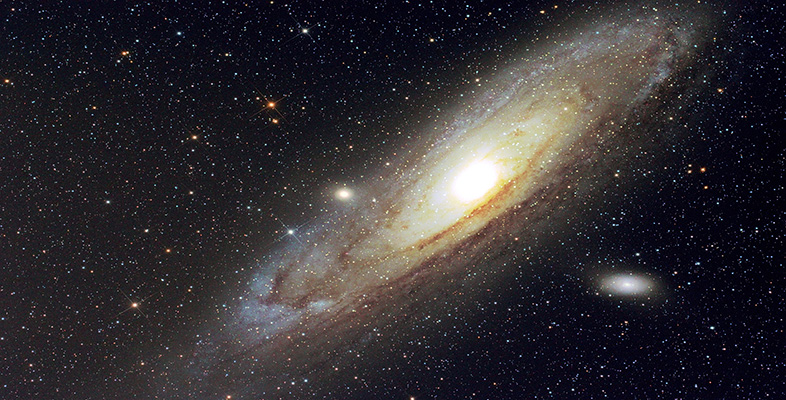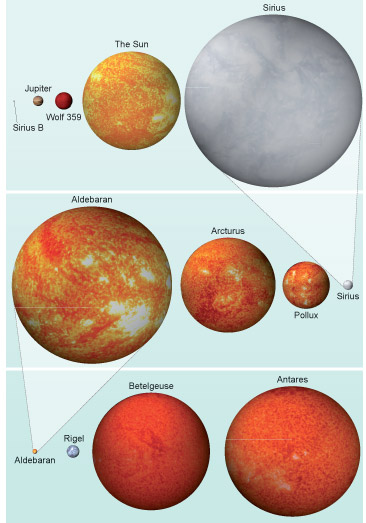5 The Sun and stars
Safety warning
Never look directly at the Sun, either with the unaided eye or through spectacles, binoculars or a telescope. You risk permanently damaging your eyes if you do so.
The part of the Sun that you normally see is called the photosphere (meaning 'sphere of light'); this is best thought of as the 'surface' of the Sun, although it is very different from the surface of a planet such as Earth. The photosphere is not solid. Rather, it is a thin layer of hot gaseous material, about 500 kilometres deep, with an average temperature of about 5500 °C or 5800 K.
Figure 8a shows a visible light image of the Sun. Sunspots (Figure 8b) appear as small dark patches on the photosphere, which typically survive for a week or so, and sometimes for many weeks. The longer-lasting sunspots can be photographed repeatedly as they cross the face of the Sun so they can even be used to investigate the rate at which the Sun rotates. The number of sunspots changes with time, gradually increasing to a maximum every eleven years then decreasing to a minimum when no sunspots may be visible for some time - a cycle intimately linked to changes in the Sun's magnetic field. A close-up view of the visible surface of the Sun (Figure 8b) also reveals a seething pattern of granules seen all across the photosphere. Individual granules, resulting from upwelling hot gas due to convection (an important process in stellar energy transport) come and go in a few minutes, often to be replaced by other granules.
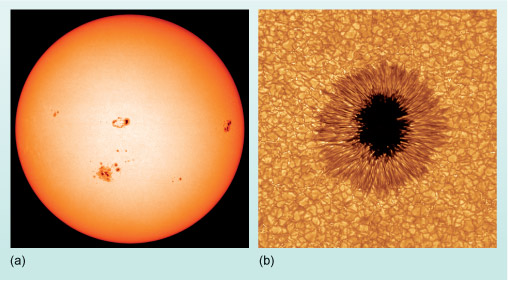
Detailed studies of the body of the Sun usually require special equipment. However, the natural phenomenon known as a total eclipse of the Sun provides an opportunity to gain further insight into the nature of the Sun (see Figure 9). A total eclipse happens when the Moon passes in front of the Sun and blocks out the bright light from the photosphere.
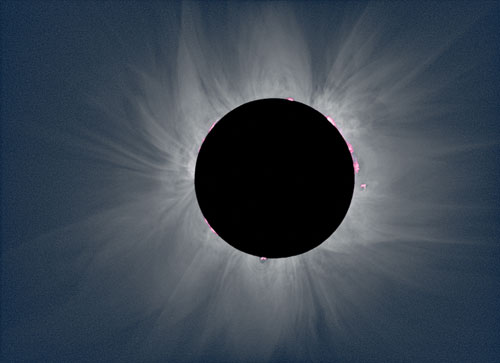
When the Moon just eclipses the bright photosphere, it is often possible to see part of a narrow, pink-coloured ring that encircles the Sun. This is the chromosphere (meaning 'sphere of colour'), the lower or 'inner' part of the Sun's atmosphere. It is actually another layer of gaseous material, a few thousand kilometres thick, which sits on top of the photosphere. The lower parts of the chromosphere are cooler than the photosphere, while the higher parts are considerably hotter, but the chromospheric material is so thin that it emits relatively little light, and is therefore unseen under normal conditions.
As a total solar eclipse proceeds, a third part of the Sun is seen - the corona (meaning 'crown'). This is the extremely tenuous (i.e. thin) upper atmosphere of the Sun that extends to several times the Sun's photospheric radius. The corona sometimes looks like streamers or plumes, but its shape changes from eclipse to eclipse, although it will not usually show any changes during the few minutes of totality that characterise a typical total eclipse. The corona is very hot (temperatures of several million kelvin are not unusual) but it is so thin that its pearly white light is very faint compared with the light from the photosphere.
The corona may be faint, but it does glow. Why are we not normally aware of the Sun's corona?
The bright light from the Sun's photosphere is scattered by the Earth's atmosphere. This makes the sky blue and generally rather bright. As a result, the much fainter light from the corona can't be seen (rather as the light from a dim torch is unnoticeable on a bright sunny day).
Sometimes in eclipses observers also see prominences - great spurts of hot material at the edge of the Sun, extending outwards from the solar surface for many thousands of kilometres. Prominences and the changing shape of the corona indicate that the Sun is an active body, not just a quietly glowing source of light. When the Sun is observed with instruments that can detect electromagnetic radiation other than visible light, it is possible to see the full extent of the activity of the Sun.
Prominences, sunspots and other features of the Sun seen at different wavelengths are indicative of active regions, generally caused by the Sun's magnetic field, which influences the flow of hot gaseous material on the Sun. Sudden changes to the magnetic field in the corona are thought to be responsible for flares, one of the most energetic of all solar phenomena, which emit bursts of radiation of all wavelengths, from radio waves to gamma-rays as well as energetic particles (such as fast-moving protons and electrons).
The Sun is a typical star and only appears much brighter than other stars because they are so much further away. Astronomers can use this to deduce the actual distances to stars. One important observation makes this easier: namely, stars that are the same size and colour give out the same amount of light. So, if astronomers observe two stars of exactly the same colour, they can start by assuming they are the same size and therefore they must be giving out the same amount of light. If one looks fainter, it must be further away. By measuring the amount of light entering a telescope from each star, astronomers can work out just how much further away one star is than the other. Figure 10 shows the principle. Stars A and B give out the same amount of light, but B is at twice the distance of A, so its light is more spread out by the time it reaches an observer on Earth. Four (2 × 2) times as much light from A enters the telescope (or eye), so A appears four times brighter.
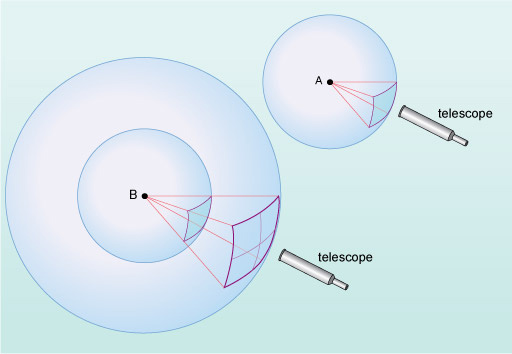
Powers
When a number is multiplied by itself, the result is called the square of that number. For example, multiplying three by three gives nine. Nine is said to be 'the square of three' or 'three squared'. This is expressed mathematically as 32, which means 3 × 3. The cube of a number is that number multiplied by itself three times, so three cubed = 3 × 3 × 3 = 33. Note that 33 can also be described as 'three to the power of three'.
What is the general rule for describing how the apparent brightness of a star diminishes with distance?
The general rule is that the apparent brightness diminishes with the square of the distance.
So if the distance is multiplied by 2, the apparent brightness is reduced by 22 = 2 × 2 = 4. If the distance is multiplied by 5, the apparent brightness is reduced by 52 = 5 × 5 = 25, i.e. such a star has 1/25 of the apparent brightness of a similar star lying at 1/5 of its distance.
Squares can also be worked out backwards so that as nine is three squared, three is the square root of nine, written
 , and as 27 is three cubed, three is the cube root of 27, thus
, and as 27 is three cubed, three is the cube root of 27, thus  .
.
The apparent brightness of a star (or any other luminous object) is therefore said to obey an inverse square law.
If star B is 10 times the distance of identical star A, how much brighter would A appear?
Star A would appear 10 × 10 = 100 times brighter than star B.
In practice, it is not quite so easy to measure distance, because some stars are the same colour but different sizes and so give out different amounts of light - but the general principle of 'faint means far' underlies many of the techniques for measuring distances. Figure 11 shows that stars have different colours. These colours are related to the temperatures of the stars. The Sun is yellowish, with a photospheric temperature of about 5800 K. Bluish-white stars are hotter than the Sun and orange-red stars are cooler. Stellar temperatures range from less than 2000 K to over 40 000 K.
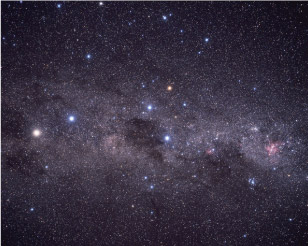
Stars come in a range of sizes, masses and luminosities. White dwarfs are only around the size of the Earth whereas some red giants are so large that if placed at the location of the Sun, they would engulf the Earth! The masses of stars, however, cover a much smaller range. The least massive are around ten percent of the mass of the Sun and the most massive around a hundred solar masses. The mass of the Sun, 1 solar mass, denoted ![]() , provides another commonly used unit in astronomy. The subscript symbol
, provides another commonly used unit in astronomy. The subscript symbol ![]() represents the Sun, so the radius of the Sun is
represents the Sun, so the radius of the Sun is ![]() and the luminosity (the total power output) of the Sun is
and the luminosity (the total power output) of the Sun is ![]() . The luminosities of stars range from less than a thousandth of the solar luminosity to greater than
. The luminosities of stars range from less than a thousandth of the solar luminosity to greater than ![]() . Figure 12 shows examples of different types of stars. A wide variety of combinations of properties are found, such as small, cool, faint red dwarfs and large, hot, highly luminous supergiants. However, some types are more common than others and not all possible combinations of these properties are found among the stars that have been observed.
. Figure 12 shows examples of different types of stars. A wide variety of combinations of properties are found, such as small, cool, faint red dwarfs and large, hot, highly luminous supergiants. However, some types are more common than others and not all possible combinations of these properties are found among the stars that have been observed.
